How to Draw a Cool German Shepherd
1000erman shepherds are big and royal dogs who make bang-up companions. They also brand great subjects for drawing studies. A german language shepherd drawing is a fantastic way to practise many of the cardinal skills in realistic animal drawing. In this realistic german shepherd drawing tutorial, we take you lot through all the steps necessary to capture the details and coloring in this dear dog. Collect your drawing supplies, get comfy, and let united states begin!
Table of Contents
- 1 German Shepherd Cartoon Tutorial
- i.1 Footstep i: Amalgam the Primary Body of Your High german Shepherd Sketch
- ane.2 Step 2: Constructing the Caput of Your German Shepherd Sketch
- i.3 Step iii: Constructing the Muzzle of Your German Shepherd Drawing
- 1.4 Step 4: Constructing the Ears of Your Dog
- i.v Step 5: Constructing the German Shepherd's Front Legs
- 1.6 Step 6: Amalgam the German Shepherd's Back Legs
- 1.seven Footstep 7: Drawing the Final Outline
- one.8 Step 8: Calculation the Detailing and Fur
- i.9 Step nine: Adding the Get-go Glaze of Color
- 1.10 Step ten: Adding Shadows
- ane.11 Pace 11: Adding Highlights
- i.12 Pace 12: Adding the Second Glaze of Color
- 1.13 Step thirteen: Finalizing the Facial Details
- 1.fourteen Step 14: Finishing Your Realistic German Shepherd Drawing
- 2 Frequently Asked Questions
- 2.1 What Is the Nearly Difficult Part of a German Shepherd Cartoon?
- 2.2 Can These Instructions be Used to Describe Other Types of Dog?
German Shepherd Drawing Tutorial
The image below is the final german shepherd sketch that you lot volition attain by the finish of this tutorial. German language shepherds have quite a unique physiology, with their sloping dorsum legs, large ears, and long muzzle. The coloring of a high german shepherd is also dissimilar many other dogs. Nailing these physiological and color characteristics will guarantee y'all a realistic german shepherd drawing. Every artist has their own unique style, and this should always testify through in your last product. As such, exercise not wait your german language shepherd sketch to expect exactly like ours.
You can use any medium of your choice to complete this tutorial. Whether you use a graphic tablet, or y'all adopt the allure of watercolor paint, you lot can simply adapt the instructions to suit your techniques.
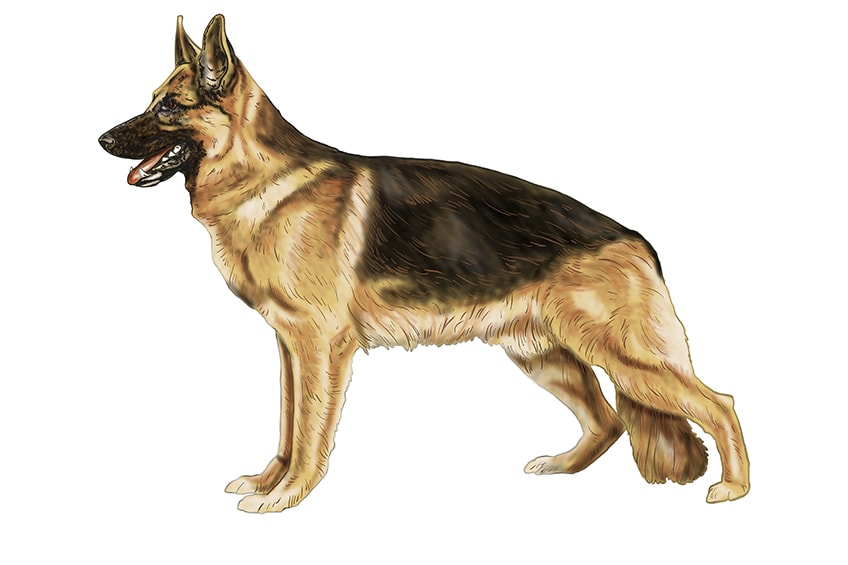
Step 1: Constructing the Master Body of Your German Shepherd Sketch
For all of our animal drawing tutorials, we always begin by using construction lines to lay down the basic shape and proportions of our brute. Beginning with the largest office of the german shepherd, we are going to employ an elongated oval to stand for the principal body shape. In this very get-go step, you need to be aware of the final shape of your german shepherd sketch. The german shepherd is facing to the left of the canvas, and as a event, this side of the oval should be higher than the other. This slope volition help you lot nail the sloping hips in your german shepherd cartoon.
Our tiptop drawing tip for this first step is to make sure that your main body construction oval is at the very center of your canvas. You will be adding legs and a head to this oval, and then you lot need plenty of infinite!

Step 2: Constructing the Head of Your German Shepherd Sketch
This 2d pace in our realistic german shepherd cartoon tutorial is very uncomplicated. For the head, you can utilize a construction circle that is e'er-so-slightly oval. Place this head circle simply higher up the right finish of the main body oval.
You tin come across on our example beneath that our circle is slightly oval and that it is angled downward, with one cease facing the bottom left of the canvas. This item will help make the construction of the german shepherd's face easier down the line.

Pace 3: Constructing the Muzzle of Your German Shepherd Cartoon
If y'all take another look at the finished drawing at the top of this tutorial, you will see that the mouth of the german shepherd is open up slightly. In this footstep, we are going to apply construction lines to lay the foundations for this muzzle. Brainstorm by cartoon a slightly uneven "U" shape that extends from the caput circumvolve down towards the left side of the canvas.
Start where this get-go upper "U" shape ends, draw some other, smaller "U" shape to represent the lesser jaw of your german shepherd drawing.
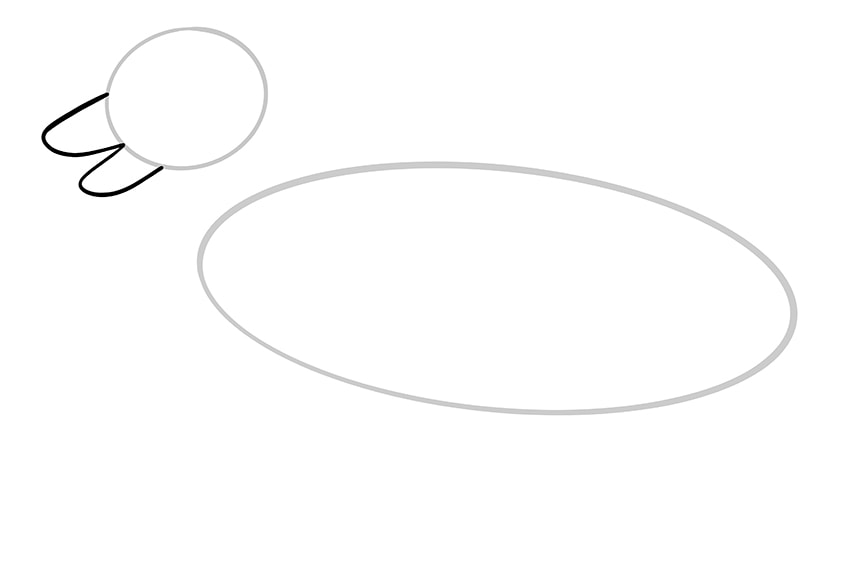
Footstep 4: Constructing the Ears of Your Dog
One of the most characteristic features of german shepherds is their big and upright ears. To create the basis for these ears, you can use a simple curved "M" shape on tiptop of the head structure circumvolve. Although cartoon an "One thousand" shape is adequately elementary, you lot do demand to pay attention to the perspective.
The ear towards the forepart of the head is further away from us, and it will therefore be slightly narrower than the dorsum i because it appears smaller and because the base of operations will be slightly subconscious by the ear closest to us.

Step 5: Constructing the German Shepherd's Front end Legs
Because the german shepherd in our sketch is standing still, the ii front legs are fairly direct and sit down side-by-side. To capture the joint for this realistic german language shepherd drawing, yous are going to use a total of six lines for the leg closest to u.s.a., and four for the dorsum one.
Once again, we need to remember to consider the perspective of our drawing in this step. The leg that is closest to the left side of the canvas is further abroad from united states, and information technology is therefore slightly shorter and the majority of it is hidden by the leg closest to us.
Brainstorm with the whole leg, which is the one that is closest to the states. From nearly 1/5th of the style into the front of the trunk oval, depict a line that goes direct down. This line can be slightly angled, but not likewise much. At present, draw a smaller line that angles slightly towards the front of the german language shepherd. To consummate this leg, take some other line down from the master body at more of an angle, and then describe a matching short line.
Y'all can divide the peak and bottom parts of the leg with a single line, and and so depict an oval at the end of the leg to represent the foot.
For the 2nd leg, only depict the far-left line that curves slightly at the top equally it leaves the chief trunk oval. describe in the joint and human foot construction lines in the same mode equally you did for the other leg.

Step 6: Amalgam the German Shepherd's Dorsum Legs
The process of this step is very like to the previous one, except that the angles are more extreme and the lines can exist slightly curved.
Start with the back leg that is farther abroad from united states, using a line that curves slightly towards the back of the canvas. Add the ankle joint using a brusk line that curves towards the front of the canvas, before finishing the leg with a longer foot oval, every bit this foot is side-on. Complete the back lines of this leg in the same way. For the very dorsum leg, you can simply repeat these steps, making the leg thicker and more curved. The ankle joint tin can also be less curved towards the front of the canvas.
At the end of this step, you will encounter the high german shepherd shape coming through quite conspicuously. In the adjacent step, yous are going to employ this basic shape to create the concluding outline of your realistic high german shepherd drawing.

Step 7: Drawing the Final Outline
In this step, you can use all the previously drawn structure lines to help y'all outline the concluding torso of your german shepherd drawing. Begin with the head, using a curved line to hide the ear that is furthest out, and and then outlining the ears with a more realistic shape. Add together some inner curved lines to create the inner eardrum. Add together the small heart detail on the side of the german shepherd's face up.
Y'all tin trace the muzzle construction lines quite closely and add together a pocket-size nose patch. When you get to the lesser jaw, describe in the ii large canine teeth, some back teeth, and the german shepherd'southward tongue.
Add some bulges to the bottom neckline, and then accept this line down to the legs and paws. You can trace the legs quite closely, but use some brusk strokes forth the back of them to create the impression of fur. Y'all tin can go along to utilize these short strokes to trace the abdomen of your german language shepherd sketch into the kickoff back leg. Apply the same short fur strokes to outline the front of the very back thigh and adding in a fluffy tail between the back legs. Stop outlining the back legs in a unmarried line so have this line all the fashion up the back to bring together with the head.
When y'all are finished with this step and you lot are happy with your outline, you lot can erase whatsoever of the remaining construction lines.

Stride 8: Adding the Detailing and Fur
In this stride, you are going to add together fur detailing throughout the body of your high german shepherd sketch. Y'all are also going to add detailing to your german language shepherd'south face.
Begin by adding some shading to the lower one-half of the german shepherd's nostrils and below its jaw. And then, apply some brusque strokes and dots to add some textural shading all around the german shepherd's mouth and muzzle. Y'all can as well add together some shading details to the teeth and the edge of the tongue. To create additional realism in the face of your german shepherd drawing, you can add together some shading around the eyes and in the ear curves.
To depict the fur, information technology is important to consider the shape of your german shepherd. You want the hairlines to period in the same direction as the torso does. For example, the hair on the cervix and back should period downwardly towards the back of the canvass. On the belly, tail, and back legs, y'all can straight the menstruum of the fur downwards.
For the almost realistic german shepherd drawing, make sure that the hair lengths on the head are the shortest, and equally you motion downwards the trunk, they should get longer.
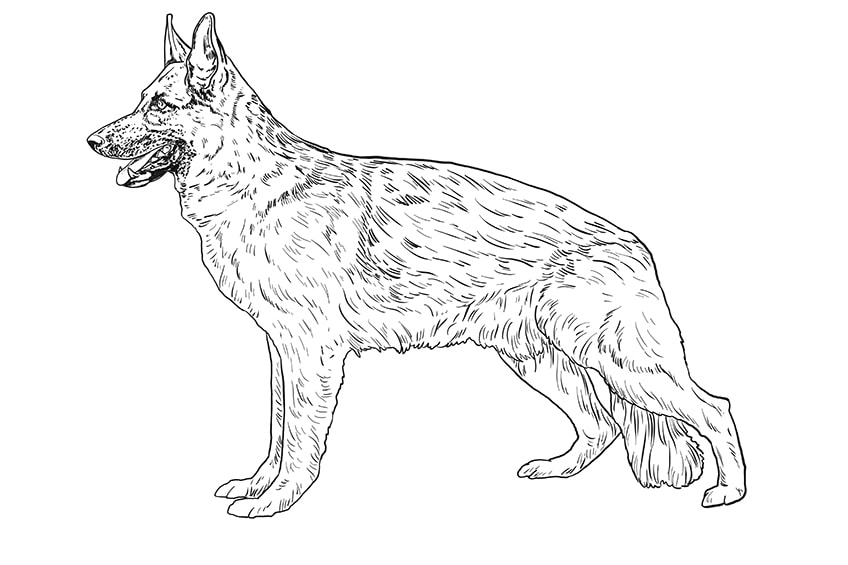
Stride 9: Adding the Kickoff Coat of Color
To get a realistic coloring for your high german shepherd drawing, y'all need to layer up a few different shades. We begin past calculation a unmarried calorie-free base colour, and and so we volition add a second color coat and shading, and highlights to create depth and dimension.
For the base color of your realistic german language shepherd drawing, cull a light shade of brown or caramel. You can utilise this shade to color the entire body of your german shepherd.

Step 10: Adding Shadows
For this step, choose a slightly darker and warmer shade of dark-brown to add some shading to your german shepherd sketch. Apply this coffee brownish shade to create a patchy fur look around the summit of the german shepherd's hips, shoulders, ears, muzzle, belly, and on the underside of the legs.
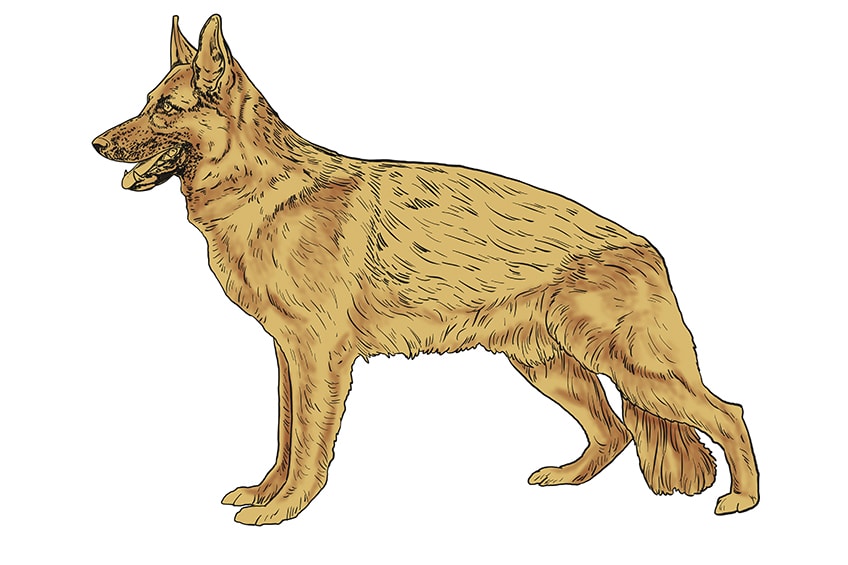
Step 11: Adding Highlights
The highlight shade you want to use for this is a light biscuit color. Use a soft brush to apply this highlight around the top of the ears, just in a higher place the shoulder, along the back of the back leg, on the belly, and on the tops of the paws. You can also add a few patches of this highlight shade throughout the trunk.
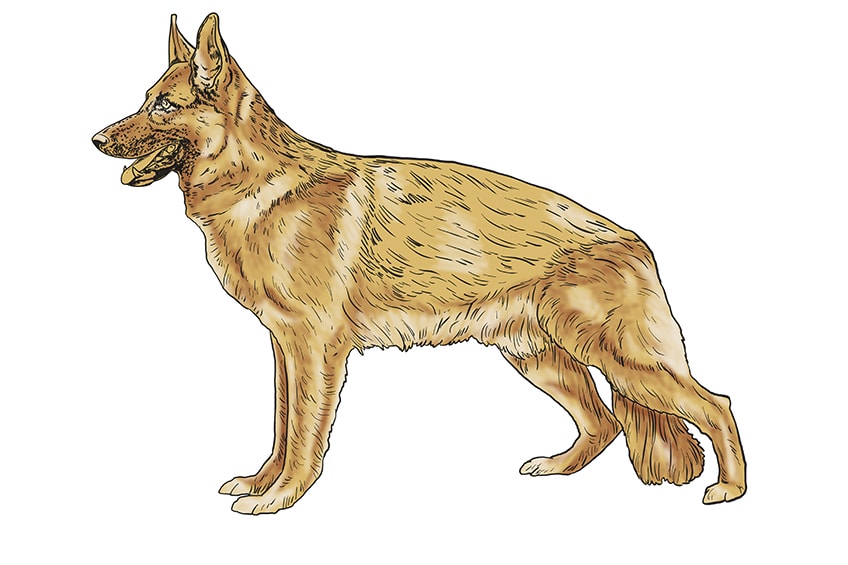
Pace 12: Calculation the 2nd Coat of Colour
The second coat colour you are going to use to create your realistic high german shepherd cartoon is black. Using a medium brush, add together a glaze of black pigment around the german language shepherd's muzzle including the lower jaw. Color the nostrils with a lighter shade of greyness, and utilize this aforementioned greyness to add shading to the within and outside of the ears, and around the centre.
Continue adding blackness along the back of the high german shepherd's spine, including the beck and back, and on the underside of the legs and tail.
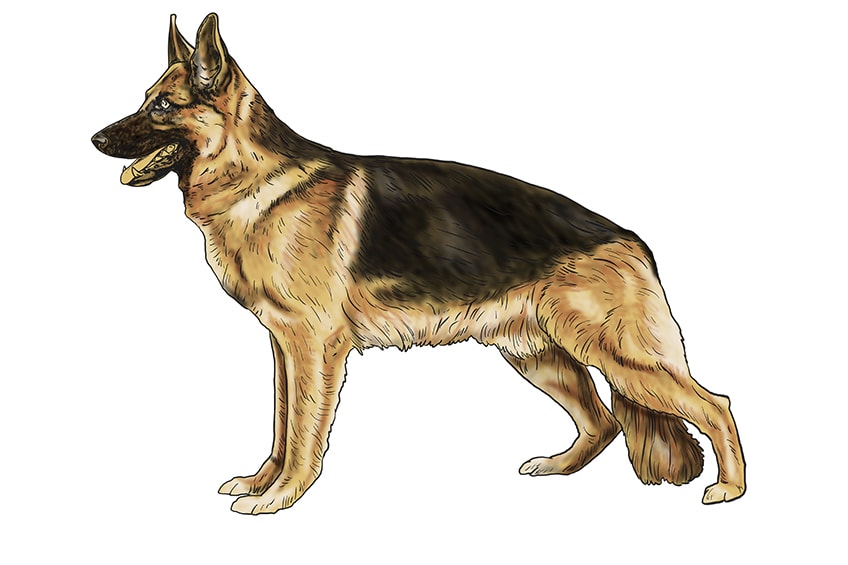
Step 13: Finalizing the Facial Details
For this last detailing step, y'all are going to demand a shade of light crimson, white, and dark-brown. Brainstorm by coloring the tongue with a light shade of red and adding a small highlight to the side with a impact of white. Color all of the visible teeth with your white shade, and add a piddling dot to the eye.
Finally, for the last facial item, use your shade of brownish to color in the eyes of your german shepherd .

Step 14: Finishing Your Realistic German Shepherd Drawing
For this very final step, you can make your cartoon even more than realistic by removing the outline and tracing over your fur strokes with your pigment. Use the colour that corresponds to that particular role of your german shepherd, and cover any outlines or fine lines that disrupt the realism of your drawing.

Congratulations for finishing your realistic german language shepherd drawing! We really hope that y'all have enjoyed the cartoon procedure and that you are happy with your final sketch. Now that you know the basic procedure of how to describe a german shepherd, y'all can modify the tutorial to depict other types of dogs.
Frequently Asked Questions
What Is the Most Difficult Part of a German Shepherd Drawing?
On the whole, this german shepherd sketch tutorial is adequately straightforward. The nigh fourth dimension-consuming and detail-oriented phase is the detailing of the face up and fur throughout the torso, but in this tutorial, we suspension the procedure downwards into very manageable steps.
Tin can These Instructions be Used to Draw Other Types of Dog?
Absolutely, you can certainly modify parts of this german shepherd drawing tutorial to aid yous depict other types of dogs. German language shepherds do have a quite specific anatomy, in particular their sloping back hips, so you will take to be enlightened of and account for this in your modifications.
Source: https://artincontext.org/how-to-draw-a-german-shepherd/
0 Response to "How to Draw a Cool German Shepherd"
Post a Comment